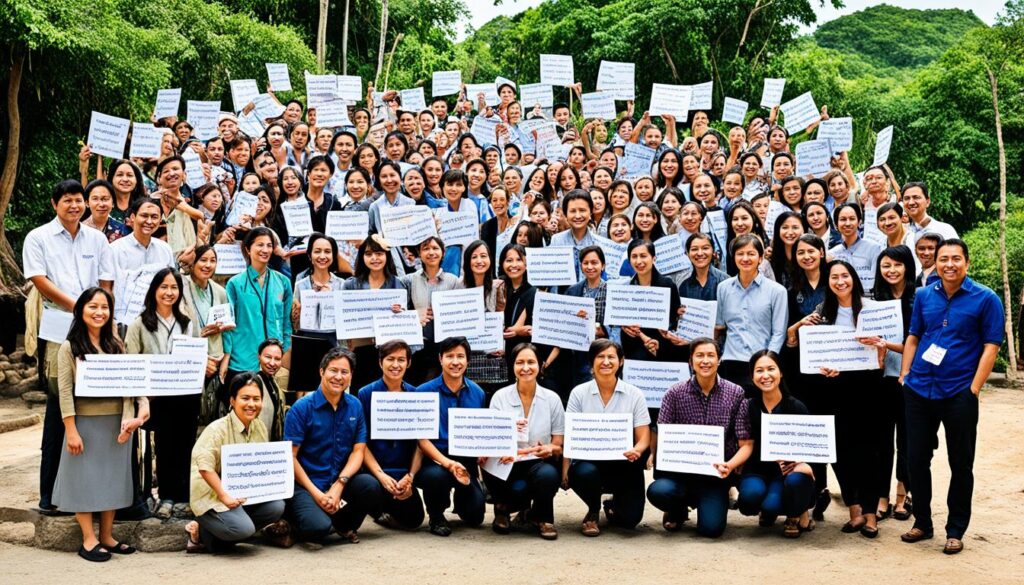Did you know that Thailand is home to 71 living languages, each contributing to the rich tapestry of the country’s cultural heritage? Among these diverse languages, the Kayo Karen Language stands out as a unique and fascinating dialect spoken by a significant ethnic group in Thailand.
Learning the Kayo Karen Language opens up a world of possibilities for cultural immersion, connecting with the local community, and deepening your understanding of Thailand’s unique linguistic landscape. Whether you are a beginner or seeking to enhance your language skills, there are numerous resources available, including online courses, classes, study materials, and beginner-friendly resources to help you embark on this linguistic adventure.
Discover the beauty and intricacy of the Kayo Karen Language as we delve into its origins, pronunciation, grammar, and vocabulary. Unlock the linguistic treasures of Thailand and explore the fascinating world of the Kayo Karen dialect.
Ready to embark on a language journey like no other? Let’s dive into the wonders of the Kayo Karen Language.
Overview of Ethnolinguistic Groups in Thailand
Thailand is a diverse country with a rich tapestry of ethnolinguistic groups, highlighting the language diversity and cultural heritage present throughout the nation. These groups represent various communities with their unique languages, traditions, and histories. The Thai ethnic group is the largest and most well-known, constituting a significant portion of the population and playing a central role in Thai society.
Beyond the Thai ethnic group, there are approximately 70 distinct ethnic groups in Thailand, each contributing to the country’s cultural mosaic. These groups stem from various language families, including Tai-Kadai, Austroasiatic, Sino-Tibetan, Austronesian, and Hmong-Mien. The table below provides an overview of the different ethnolinguistic groups in Thailand:
In addition to the Thai ethnic group, several other prominent groups exist within Thai society. These include the Lao ethnic group, who have a strong presence in the northeastern region of Thailand, the Khmer ethnic group, concentrated mainly in the eastern provinces, the Malay ethnic group, found primarily in the southernmost provinces, and the Karen ethnic group, recognized for their distinct language and cultural heritage. These ethnic groups contribute to the cultural diversity and enrich the social fabric of Thailand.
The preservation and celebration of the language diversity and cultural traditions of these ethnolinguistic groups are essential for fostering inclusivity and maintaining Thailand’s vibrant multicultural society.
Historical Development of Ethnic Groups in Thailand
The ethnic composition of Thailand has seen significant changes throughout its history, influenced by various factors such as migration, integration, and immigration. The arrival of the Tai peoples, who originated from China, played a pivotal role in shaping the ethnic landscape of Thailand.
The Tai migration to Thailand occurred over centuries as these groups gradually populated the river valleys and established powerful societies. They brought with them their language, culture, and traditions, creating a distinct presence in the region. Today, the Tai ethnic groups, including the Thai and other related subgroups, form a significant portion of the Thai population.
However, the ethnic diversity of Thailand extends beyond the Tai peoples. Over time, different ethnic groups were integrated into the Kingdom of Siam, contributing to the rich mix of cultures and communities present in Thailand. The Lao, Khmer, Malays, and Chinese are among the ethnic groups that have been introduced and integrated into Thai society.
The integration of various ethnic groups has resulted in a multifaceted society that embraces a range of traditions, languages, and customs. This integration has not only added to the diversity of Thailand’s ethnic makeup but has also fostered cultural exchange and intercultural understanding.
Chinese immigration to Thailand has been particularly influential in shaping the country’s ethnic composition. Over several centuries, Chinese immigrants have settled in Thailand, bringing their language, customs, and traditions. Today, the Chinese community in Thailand continues to contribute to the country’s cultural fabric and economic growth.
This historical development of ethnic groups in Thailand reflects the country’s openness and inclusivity towards different cultures, languages, and communities. It is through the integration of these diverse ethnic groups that Thailand has become a nation known for its cultural richness and harmony.
Chinese Immigration to Thailand
“Chinese immigration to Thailand has played a significant role in shaping the country’s cultural landscape. The Chinese community has made valuable contributions to various sectors, including business, trade, arts, and cuisine.” – Dr. Supawan Jantawiriyanon, Cultural Anthropologist
Official and Academic Position on Ethnic Groups in Thailand
The Royal Thai Government officially recognizes 62 ethnolinguistic communities in Thailand. This recognition acknowledges the linguistic and cultural diversity present within the country. However, despite this recognition, there is still a lack of disaggregated data in official Thai documents and censuses when it comes to the specific details of each ethnic group. This can lead to a conflation of different ethnic groups and a focus on Thai national identity.
“While the Royal Thai Government has made strides in acknowledging the presence of diverse ethnic groups, further efforts are needed to accurately capture the nuances and intricacies of each community. Disaggregating data in official documents and censuses would provide a more comprehensive understanding of the ethnic composition of Thailand.”
Academic research on ethnic groups in Thailand has shed light on the importance of recognizing and understanding the full extent of ethnic diversity within the country. Scholars have highlighted the need to go beyond official recognition and delve deeper into the various languages, cultures, and traditions of different communities. This research has revealed that the population of ethnic groups in Thailand is more diverse than officially recognized, with unique languages and cultural practices present among different communities.
Importance of Academic Research
Academic research plays a crucial role in expanding knowledge and challenging existing narratives. In the case of ethnic groups in Thailand, academic studies have provided valuable insights that extend beyond official recognition.
- These studies have uncovered the rich linguistic tapestry of Thailand, emphasizing the need to preserve and celebrate the various languages spoken by ethnic communities.
- They have also highlighted the cultural practices and traditions that contribute to the cultural heritage of each ethnic group.
- Academic research has shed light on the historical migration patterns and interactions between different ethnic groups, providing a deeper understanding of Thailand’s ethnolinguistic landscape.
The findings from academic research on ethnic groups in Thailand contribute to a broader perspective that goes beyond official recognition. By acknowledging and embracing this diversity, Thailand can foster a more inclusive society that values and respects the contributions of all its ethnic communities.

Contemporary Ethnic Groups in Thailand
In contemporary Thailand, several prominent ethnic groups exist alongside the majority Thai population. These ethnic groups contribute to the cultural diversity and richness of the country. Let’s explore some of the significant ethnic groups in Thailand:
Lao Ethnic Group in Thailand
The Lao ethnic group, including the Thai Lao, has a significant presence, particularly in the northeastern region of Thailand. They have their own distinct language, culture, and traditions, which contribute to the diverse tapestry of Thai society.
Khmer Ethnic Group in Thailand
The Khmer ethnic group, with their roots in the historical Khmer Empire, is another important ethnic group in Thailand. Primarily residing in the northeastern region, they have a rich cultural heritage and their own unique language, adding to the multicultural fabric of Thailand.
Malay Ethnic Group in Thailand
The Malay ethnic group is concentrated in the southernmost provinces of Thailand, close to the border with Malaysia. They have their own language, customs, and traditions, which reflect their vibrant cultural identity and contribute to the rich diversity of Thailand.
Karen Ethnic Group in Thailand
The Karen ethnic group, also known as the Kayin, is recognized as one of the ethnic groups in Thailand. They have a population spread across different regions of the country, with significant communities in the mountainous areas. The Karen people have their unique language, culture, and traditional practices that enhance the cultural mosaic of Thailand.
These ethnic groups, among others, play a crucial role in preserving and enriching the cultural heritage of Thailand. Through their languages, traditions, and customs, they contribute to the unique cultural tapestry that makes Thailand a diverse and vibrant nation.
| Ethnic Group | Region | Language |
|---|---|---|
| Lao | Northeastern region | Lao language |
| Khmer | Northeastern region | Khmer language |
| Malay | Southern provinces | Malay language |
| Karen | Various regions | Karen language |
Conclusion
Thailand’s cultural diversity is a testament to its vibrant ethnic composition. The country is home to a myriad of ethnic groups, each with its distinct language, culture, and traditions. Embracing the rich cultural heritage of these diverse ethnic communities is key to fostering inclusivity and bolstering the social fabric of Thai society.
By recognizing and appreciating the contributions of all ethnic groups, Thailand can nurture ethnic harmony and unity. This entails celebrating the unique cultural heritage of each community, as well as providing equal opportunities and representation for all individuals. Ensuring that the voices and experiences of every ethnic group are heard and valued contributes to a more cohesive and harmonious Thai society.
The cultural heritage of ethnic groups in Thailand is a source of pride and a national treasure. Preserving and promoting their traditions, languages, and artistic expressions not only enriches Thai society but also serves as a bridge to connect different cultures and foster understanding between communities. Thailand’s commitment to upholding its diverse cultural heritage strengthens its identity as a multicultural nation.
FAQ
What is the Kayo Karen Language?
The Kayo Karen Language is a unique language spoken by a significant ethnic group in Thailand. It is part of the Tai-Kadai language family and is officially recognized in the country.
Are there resources available for learning the Kayo Karen Language?
Yes, there are various resources available for learning the Kayo Karen Language, including online courses, classes, study materials, and beginner-friendly resources.
Where can I find Kayo Karen Language classes?
You can find Kayo Karen Language classes through language centers, cultural organizations, and online platforms that offer language courses.
Can beginners learn the Kayo Karen Language?
Yes, there are resources and study materials available specifically designed for beginners who want to learn the Kayo Karen Language.
Are there online courses available for learning the Kayo Karen Language?
Yes, there are online courses available for learning the Kayo Karen Language that provide a flexible and convenient way to learn at your own pace.
Are there any specific resources for Kayo Karen language learning?
Yes, there are specific resources available for Kayo Karen language learning, including textbooks, dictionaries, audio recordings, and online language learning platforms.
